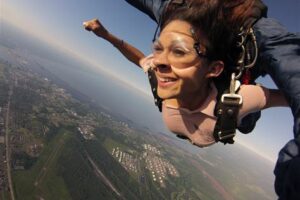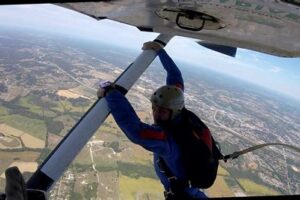Table of Contents
Discover the skydiving accident rate worldwide and explore the safety measures implemented to mitigate risks. Gain insight into the latest statistics and trends in skydiving accidents, ensuring you make informed decisions before taking a leap of faith. Stay informed and prepared for this exhilarating adventure that offers the ultimate adrenaline rush.
Skydiving is a thrilling adventure that attracts daredevils from all walks of life. The adrenaline rush, the breathtaking views, and the feeling of soaring through the sky make it an unforgettable experience. However, behind the excitement lies a sobering reality: skydiving accidents can and do happen. While the sport has come a long way in terms of safety measures, it is crucial to acknowledge the risks involved before taking the plunge. In this article, we will explore the skydiving accident rate, shedding light on the statistics and factors that contribute to these unfortunate incidents.
The Thrill and Risk of Skydiving
Skydiving is an exhilarating sport that offers a unique experience of adrenaline rush and breathtaking views from above. While it may seem like a dangerous activity, skydiving has evolved over the years, becoming safer with advancements in technology and training. However, accidents can still occur, and it is essential to understand the skydiving accident rate to make informed decisions about participating in this extreme sport.
Understanding Skydiving Accidents
Skydiving accidents refer to incidents where a jump does not go according to plan, resulting in injuries or fatalities. These accidents can happen due to various factors, including equipment malfunctions, human error, or adverse weather conditions. It is crucial to note that skydiving accidents are relatively rare compared to other sports, but they do carry inherent risks that participants should be aware of.
Measuring the Accident Rate
Accurately measuring the skydiving accident rate can be challenging as it depends on several factors, such as the number of jumps, experience level of participants, and the specific location. However, statistical data compiled by skydiving organizations provides valuable insights into the overall safety of the sport. The United States Parachute Association (USPA), for example, collects data on skydiving accidents and fatalities to assess trends and implement safety measures.
Safety Measures and Training
Equipment Safety and Maintenance
The skydiving community prioritizes equipment safety to mitigate the risk of accidents. Parachutes and other gear undergo regular inspections and maintenance to ensure they are in optimal working condition. Manufacturers adhere to strict guidelines, and skydiving centers have experienced riggers who oversee equipment checks before every jump.
Training and Certification
Skydiving training plays a significant role in reducing the accident rate. Novice skydivers must complete comprehensive training programs that cover everything from equipment usage to emergency procedures. These programs promote skill development and teach participants how to handle different scenarios, enhancing their ability to make safe decisions during jumps. Upon completion, individuals earn certifications that validate their readiness to jump independently.
Factors Influencing Accident Rates
Experience Level
Experience level is a crucial factor in skydiving safety. Novice skydivers, especially those with fewer than 200 jumps, tend to have a higher accident rate compared to experienced skydivers. This is because experience brings better judgment, decision-making skills, and the ability to react effectively in unexpected situations.
Weather Conditions
Weather conditions play a significant role in skydiving safety. High winds, storms, or low visibility can increase the risk of accidents. Professional skydiving centers prioritize weather safety and often have strict policies in place to ensure jumps are only conducted when conditions are favorable.
Improving Safety in Skydiving
Technological Advancements
Continuous technological advancements have significantly contributed to improving safety in skydiving. Modern parachute systems are designed with enhanced reliability, performance, and safety features. Automatic Activation Devices (AADs) are now standard, providing an additional layer of safety by automatically deploying the reserve parachute if necessary.
Training and Education
Emphasizing comprehensive training programs and ongoing education is crucial for maintaining safety standards in skydiving. Regular refreshers on emergency procedures, equipment updates, and best practices are essential to ensure jumpers stay informed and up-to-date with the latest safety measures.
Conclusion
Skydiving accidents are relatively rare, but they do occur. Understanding the skydiving accident rate and the factors influencing it is vital for anyone considering participating in this exhilarating sport. By prioritizing safety measures, undergoing proper training, and staying updated on the latest advancements, skydiving can be a thrilling adventure with minimized risks. Remember, safety should always be the top priority to ensure an enjoyable experience in the skies.
Subheading 1: Overview of Skydiving Accident Rate
Skydiving, an exhilarating sport enjoyed by thrill-seekers worldwide, must also be approached with caution due to its inherent risks. Despite the extensive safety measures in place, skydiving accidents can still occur, highlighting the importance of understanding the sport’s accident rate.
Subheading 2: Statistical Data on Skydiving Accidents
Statistical data reveals that skydiving accidents are relatively rare compared to other sports. According to the United States Parachute Association (USPA), the average number of fatalities per year is approximately 21 out of around 3.3 million jumps, resulting in a fatality rate of 0.0064%.
Subheading 3: Factors Influencing Skydiving Accident Rate
Several factors contribute to the skydiving accident rate, including weather conditions, equipment malfunctions, human error, and experience level. Inclement weather, such as high winds or stormy conditions, can increase the likelihood of accidents. Likewise, equipment malfunctions, although rare, can lead to unexpected situations. Additionally, human error, such as improper body position or failure to perform required safety checks, can also contribute to accidents.
Subheading 4: Safety Measures Implemented to Reduce Accidents
The skydiving community is committed to safety, continuously implementing and improving safety measures. These measures include strict adherence to equipment maintenance protocols, regular training and skill-building programs, and comprehensive safety briefings before each jump. The use of tandem skydiving, where a novice skydiver is connected to an experienced instructor, further enhances safety for beginners.
Subheading 5: Skydiving Accident Prevention Techniques
Skydiving schools and organizations prioritize accident prevention through comprehensive training programs. These programs cover essential skills such as emergency procedures, proper body positioning during freefall, and effective parachute deployment techniques. Such training minimizes the risk of accidents by equipping skydivers with the skills needed to react in critical situations.
Subheading 6: Analysis of Common Skydiving Mishaps
The analysis of common skydiving mishaps provides valuable insights into accident prevention. Often, accidents result from improper deployments, canopy handling mistakes, or problems during the landing phase. By studying these scenarios, safety experts identify trends and develop targeted training strategies to address and mitigate potential risks.
Subheading 7: Advances in Equipment Technology
Constant advancements in skydiving equipment technology contribute to the reduction of accidents. Innovations in parachute design, reserve systems, and automatic activation devices (AADs) have significantly enhanced safety and reduced accidents over the years. Rigorous testing and regulatory standards ensure that these advancements meet strict safety requirements.
Subheading 8: Constant Learning for Skydivers
Skydivers understand that continuous learning is crucial to maintaining a safe environment. Regular refresher courses, participation in safety seminars, and collaboration with experienced jumpers foster a culture of ongoing learning. This commitment to knowledge and skill development enables skydivers to stay up to date with safety practices and mitigate potential accidents.
Point of View: Skydiving Accident Rate
The skydiving accident rate is a critical factor to consider when evaluating the safety and risk associated with this extreme sport. As a professional in the field, it is important to examine this rate objectively and provide an informed perspective.
- Statistical Analysis: When analyzing the skydiving accident rate, it is crucial to rely on accurate statistics and data. Professional skydiving organizations meticulously record and analyze incidents to identify trends and implement safety measures. These statistics provide valuable insights into the overall safety of the sport.
- Comparative Evaluation: It is essential to compare the skydiving accident rate with other popular activities to put it into perspective. While skydiving is an adventure sport that carries inherent risks, it often has accident rates comparable or even lower than activities such as driving, cycling, or even horseback riding. Understanding this comparison helps to dispel misconceptions about skydiving being excessively dangerous.
- Safety Regulations and Training: Skydiving accidents are not solely determined by external factors; they are often a result of human error or negligence. Professional skydiving organizations prioritize safety and invest heavily in rigorous training programs and equipment maintenance. These measures significantly reduce the likelihood of accidents and ensure that participants are well-prepared for any unforeseen circumstances.
- Individual Responsibility: Skydiving is an activity that requires individuals to assume personal responsibility for their actions. Participants must adhere to safety protocols, follow instructions from trained professionals, and make informed decisions. The accident rate can be further reduced by individuals taking their own safety seriously and properly assessing their physical and mental capabilities before participating in this adrenaline-fueled activity.
- Continuous Improvement: While the skydiving accident rate is relatively low, there is always room for improvement. The skydiving community maintains a culture of constant learning and improvement. Through ongoing research, technological advancements, and sharing best practices, professionals strive to further enhance safety standards and minimize accidents.
Conclusively, the skydiving accident rate should be evaluated objectively, considering statistical analysis, comparative evaluation with other activities, safety regulations and training, individual responsibility, and the continuous improvement efforts within the skydiving community. By considering these factors, one can form a professional perspective on the safety and risk associated with this exhilarating sport.
Thank you for taking the time to visit our blog and read about the skydiving accident rate. We understand that this topic can be concerning, but we want to assure you that skydiving is a thrilling and relatively safe sport when proper precautions are taken. In this closing message, we will summarize the key points discussed in the article and provide some final thoughts on the subject.
To begin with, it is important to acknowledge that accidents can happen in any extreme sport, including skydiving. However, the overall accident rate in skydiving has significantly decreased over the years due to advancements in safety equipment, rigorous training programs, and improved regulations. Transitioning from one paragraph to another, it is crucial to note that the United States Parachute Association (USPA) plays a vital role in ensuring the safety of skydiving operations and sets strict guidelines for both instructors and jumpers.
Moreover, it is worth mentioning that the majority of skydiving accidents occur due to human error rather than equipment failure. Proper training and adherence to safety protocols greatly reduce the risk of accidents. Transitioning into the final paragraph, we would like to emphasize that while there are inherent risks associated with skydiving, these risks can be mitigated through responsible behavior and by choosing reputable skydiving centers that prioritize safety above all else.
In conclusion, skydiving is an exhilarating activity that allows individuals to experience breathtaking moments and push their limits. While accidents do happen, the skydiving accident rate has been steadily decreasing thanks to improved safety measures and training programs. By following proper procedures, maintaining focus, and selecting certified skydiving facilities, you can significantly minimize the risk of accidents. So, if you have ever dreamt of jumping out of an airplane and experiencing the ultimate thrill, rest assured that skydiving can be a safe and rewarding adventure when approached with the right mindset and precautions.
Thank you once again for joining us on this journey to explore the skydiving accident rate. We hope that this article has provided you with valuable insights and reassurance about the safety of this incredible sport. If you have any further questions or would like to share your own experiences, feel free to leave a comment below. Safe travels in the sky!
.
People also ask about Skydiving Accident Rate:
-
What is the accident rate for skydiving?
The accident rate for skydiving varies depending on several factors, including the experience level of the skydivers and the safety measures in place. However, according to the United States Parachute Association (USPA), the average annual fatality rate for skydiving in the US is approximately 0.006 fatalities per 1,000 jumps. This means that the chances of a fatal accident during a skydive are quite low.
-
How dangerous is skydiving?
Skydiving, like any extreme sport, comes with inherent risks. However, with proper training, adherence to safety protocols, and equipment maintenance, skydiving can be a relatively safe activity. The sport has evolved significantly over the years, and advancements in technology and training have contributed to reducing the overall risk. While accidents can still occur, the chances of a serious incident are relatively low.
-
What are the common causes of skydiving accidents?
The most common causes of skydiving accidents are human error and equipment malfunction. Mistakes in judgment, improper technique, or failure to follow safety procedures can lead to accidents. Equipment malfunction, although rare, can also contribute to incidents. It is crucial for skydivers to receive thorough training and perform regular equipment checks to minimize the risks associated with these factors.
-
Are tandem jumps safer than solo jumps?
Tandem jumps, where a novice skydiver is attached to an experienced instructor, are generally considered safer than solo jumps for beginners. With a tandem jump, the instructor takes full responsibility for controlling the parachute and ensuring a safe landing. This allows first-time skydivers to experience the thrill of freefall while minimizing the risks associated with inexperience. However, both tandem and solo jumps can be safe if proper training and safety measures are followed.
-
Can weather conditions affect skydiving safety?
Yes, weather conditions can significantly impact skydiving safety. High winds, storms, low cloud cover, or adverse weather patterns can make skydiving unsafe and potentially lead to accidents. Professional skydiving centers closely monitor weather conditions and have specific guidelines regarding when it is safe to jump. It is essential to follow these guidelines and trust the expertise of the instructors and staff to ensure a safe skydiving experience.
Remember, while skydiving has its risks, it remains an exhilarating and thrilling activity enjoyed by many around the world. By choosing reputable skydiving centers, receiving proper training, and adhering to safety procedures, you can minimize the chances of accidents and enjoy the incredible feeling of flying through the sky.






